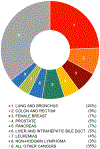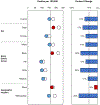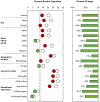Annual report to the nation on the status of cancer, part II: Progress toward Healthy People 2020 objectives for 4 common cancers
- PMID: 32162329
- PMCID: PMC7223723
- DOI: 10.1002/cncr.32801
Annual report to the nation on the status of cancer, part II: Progress toward Healthy People 2020 objectives for 4 common cancers
Abstract
Background: The Centers for Disease Control and Prevention, the American Cancer Society, the National Cancer Institute, and the North American Association of Central Cancer Registries collaborate to provide annual updates on cancer occurrence and trends in the United States and to address a special topic of interest. Part I of this report focuses on national cancer statistics, and part 2 characterizes progress in achieving select Healthy People 2020 cancer objectives.
Methods: For this report, the authors selected objectives-including death rates, cancer screening, and major risk factors-related to 4 common cancers (lung, colorectal, female breast, and prostate). Baseline values, recent values, and the percentage change from baseline to recent values were examined overall and by select sociodemographic characteristics. Data from national surveillance systems were obtained from the Healthy People 2020 website.
Results: Targets for death rates were met overall and in most sociodemographic groups, but not among males, blacks, or individuals in rural areas, although these groups did experience larger decreases in rates compared with other groups. During 2007 through 2017, cancer death rates decreased 15% overall, ranging from -4% (rural) to -22% (metropolitan). Targets for breast and colorectal cancer screening were not yet met overall or in any sociodemographic groups except those with the highest educational attainment, whereas lung cancer screening was generally low (<10%). Targets were not yet met overall for cigarette smoking, recent smoking cessation, excessive alcohol use, or obesity but were met for secondhand smoke exposure and physical activity. Some sociodemographic groups did not meet targets or had less improvement than others toward reaching objectives.
Conclusions: Monitoring trends in cancer risk factors, screening test use, and mortality can help assess the progress made toward decreasing the cancer burden in the United States. Although many interventions to reduce cancer risk factors and promote healthy behaviors are proven to work, they may not be equitably applied or work well in every community. Implementing cancer prevention and control interventions that are sustainable, focused, and culturally appropriate may boost success in communities with the greatest need, ensuring that all Americans can access a path to long, healthy, cancer-free lives.
Keywords: Healthy People 2020; cancer; epidemiology; surveillance.
© 2020 American Cancer Society.
Conflict of interest statement
CONFLICT OF INTEREST DISCLOSURES
The authors have no conflicts of interest related to this work to disclose.
Figures















References
-
- U.S. Department of Health and Human Services. Healthy people 2020. 2019; https://www.healthypeople.gov/2020/topics-objectives. [accessed January 17, 2020].
Publication types
MeSH terms
Grants and funding
LinkOut - more resources
Full Text Sources
Other Literature Sources
Medical
Miscellaneous

